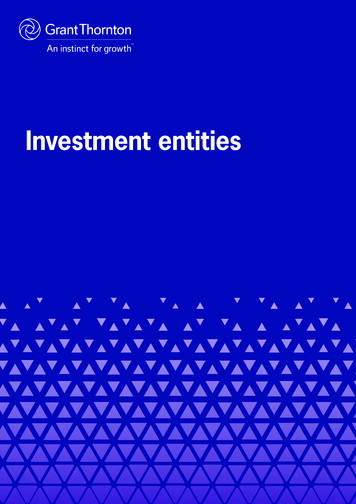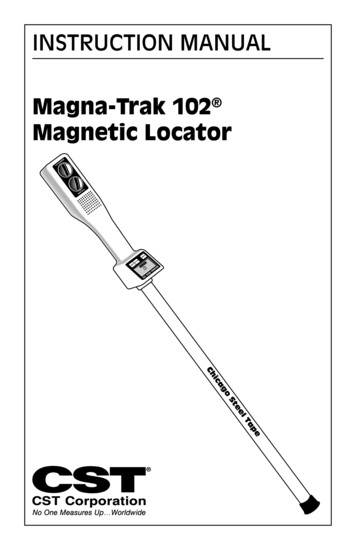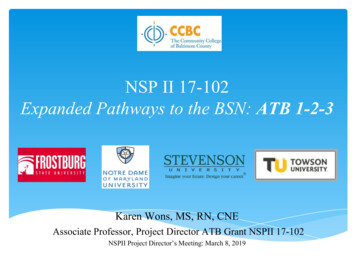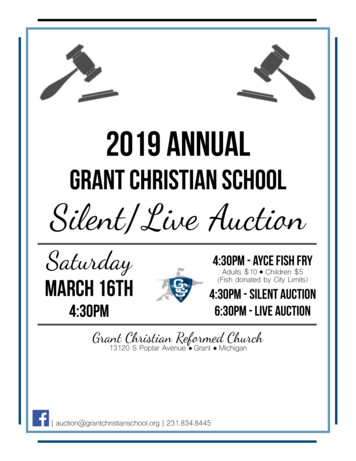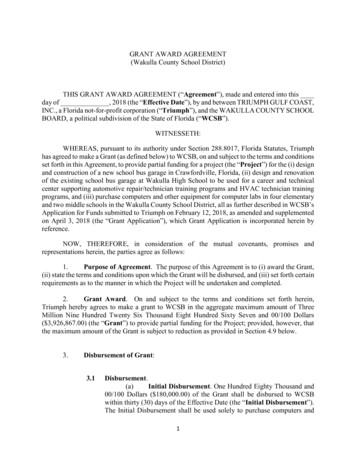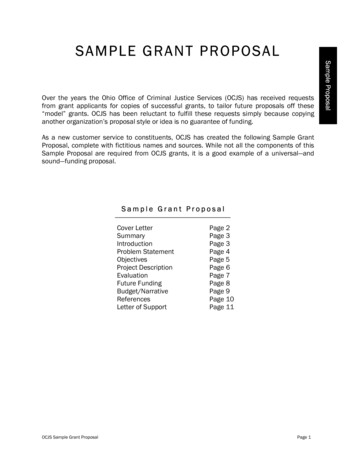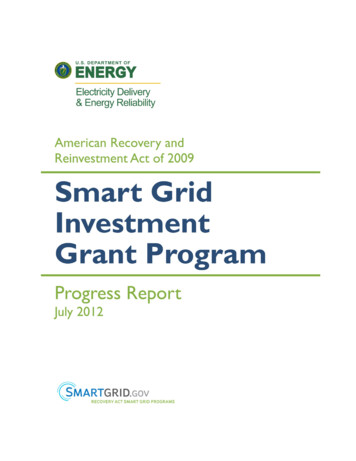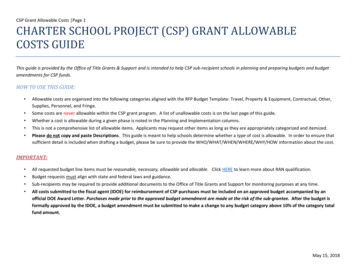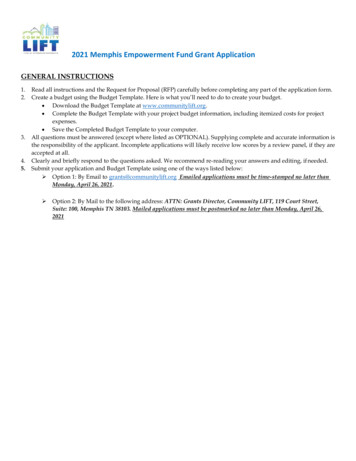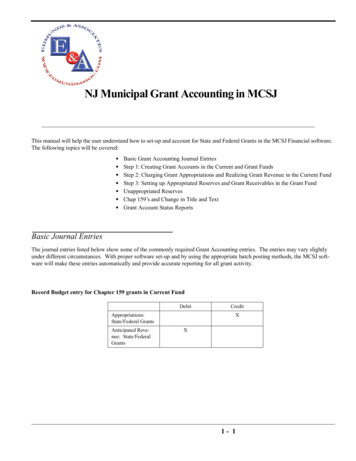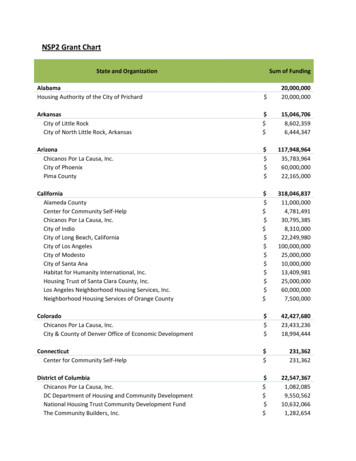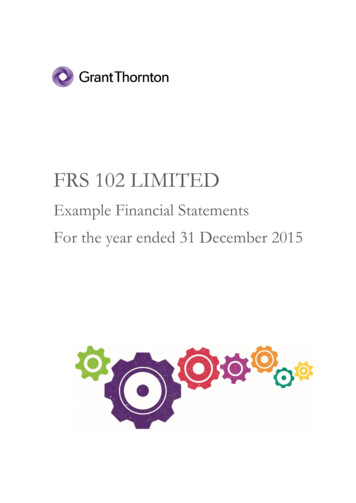
Transcription
FRS 102 LIMITEDExample Financial StatementsFor the year ended 31 December 2015
IntroductionThese illustrative financial statements are an example of a group and parent company financial statementsprepared for the first time in accordance with FRS 102 The Financial Reporting Standard applicable inthe UK and Republic of Ireland. Their preparation involved striking a balance between helpful guidanceand burdensome detail. The disclosures illustrated, therefore, do not include all possible disclosures asthis would clearly make any guidance too unwieldy to be of wide, practical use. For this reason theyshould not be used as a substitute for completing a disclosure checklist.Whilst every care has been taken in their preparation, users are advised to use these financial statementsas a guide in conjunction with the actual text of the standard and implementation guidance issued,together with relevant legislation, and to consult their professional advisers before concluding onaccounting treatments and disclosures for their own transactions and circumstances.To assist the user further, disclosure requirements introduced by FRS 102 or areas of difference incomparison to existing UK GAAP have been highlighted. Furthermore, two appendices have beenincluded to illustrate a: Statement of Comprehensive Income presented as one statement instead of two (as permitted byFRS 102.5.2(a)) Statement of Income and Retained Earnings (as permitted by FRS 102.6.4 in certain circumstances).In addition, source references for the illustrative disclosures have been included in the right hand marginof the financial statements. Examples of source references used are:4.14s408Sch 1.66(1)Conversion report page 13FRC GuidanceSI 2008/489Tech 14/13Paragraph 4.14 of FRS 102Section 408 of the Companies Act 2006Paragraph 66(1) of Schedule 1 to Statutory Instrument 2008,Number 410 The Large and Medium-sized Companies andGroups (Accounts and Reports) Regulations 2008Grant Thornton guidance 'Key Issues on Conversion to FRS 102'page 13FRC guidance on Going Concern and Liquidity Risk forDirectors of UK Companies 2009The Companies (Disclosure of Auditor Remuneration andLiability Limitation Agreements) Regulations 2008ICAEW Guidance: Disclosure of auditor remuneration 2014 Grant Thornton UK LLP. All rights reserved
FRS 102 LIMITEDCONSOLIDATED INCOME STATEMENTFor the year ended 31 December 2015Note2015 '0002014 '0005xxxxxxxxCost of salesxxxxxxxxGross profitxxxxxxxxAdministrative expensesOther operating incomexxxxxxxxxxxxxxxxOperating profitxxxxxxxx5.9BShare of operating profits of associatesxxxxxxxx14.14xxxxxxxxInterest receivable and similar incomexxxxxxxx 23.30(b)(iii)Interest payable and similar chargesxxxxxxxxTurnover5.7C11.48(b)Profit on ordinary activities before taxation6xxxxxxxxTax on profit on ordinary activities8xxxxxxxxProfit for the financial yearxxxxxxxxProfit for the financial year attributable to:Owners of the parentxxxxxxxxNon-controlling interestsxxxxxxxx11.48(b)Sch 1.66(1)5.6(a)Sch 6.17(3)9.21* The Balance Sheet and Profit and Loss Account are still required to be presentedin accordance with the Companies Act formats. The titles of these primarystatements could be changed to the FRS 102 titles, ie Statement of FinancialPosition and Income Statement, or continue to use the Companies Act format titles,ie Balance Sheet and Profit and Loss Account.* A company may present a separate Income Statement and Statement ofComprehensive Income (see page 2), or combine the two into a single Statement ofComprehensive Income (see appendix for illustration of one-statement approach).[Refer to conversion report page 13&14] 2014 Grant Thornton UK LLP. All rights reserved1
FRS 102 LIMITEDCONSOLIDATED STATEMENT OF COMPREHENSIVE INCOMEFor the year ended 31 December 20152015 '0002014 '000xxxxxxxxTotal comprehensive income for the financial yearxxxxxxxxxxxxxxxxxxxxxxxxTotal comprehensive income for the financial year attributableto:Owners of the parentNon-controlling interestsxxxxxxxxxxxxxxxxProfit for the financial yearCurrency translation differences on foreign currency netinvestmentsShare of other comprehensive income of associates5.5A30.25(b)5.6(b)* The Statement of Comprehensive Income is essentially equivalent to theStatement of Total Recognised Gains and Losses ('STRGL') under current UKGAAP. However, the STRGL only presents the parent company's share of profitsand other gains and losses, whereas a the Statement of Comprehensive Incomeincludes the non-controlling interests share of profit and other gains and losses.* Disclosure of the allocation of profits and total comprehensive income betweenowners of the parent and any non-controlling interests is required.[Refer to conversion report page 13&14] 2014 Grant Thornton UK LLP. All rights reserved2
FRS 102 LIMITEDCONSOLIDATED STATEMENT OF FINANCIAL POSITIONAs at 31 December 2015Note2015 '0002014 '000101112Current assetsStocksDebtorsCash at bank and in xxxxxxxxxxxxxxxxxxxxxxCreditors: amounts falling due within one year15xxxxxxxxNet current assetsxxxxxxxxTotal assets less current liabilitiesxxxxxxxxFixed assetsIntangible assetsTangible assetsInvestmentsCreditors: amounts falling due after more than one year16xxxxxxxxProvisions for xxxxxxxxxxxxxxxxxxxxxxxxxxxxxxxxxxxNet assetsCapital and reservesCalled up share capitalShare premium accountForeign exchange translation reserveProfit and loss account19202020Non-controlling interestsThe financial statements were approved by the Board of Directors onSigned on behalf of the board of directors:2016.ChairmanCompany registration no: XXXXXX* FRS 102 has adopted a variety of terminology from IFRS (such as property, plant& equipment for tangible assets, inventory for stocks, and current liabilities forcreditors: amounts falling due within one year). UK companies will still need tocomply with company law, which stipulates the format of, and headings to be usedin, the Balance Sheet and Profit and Loss Account.[Refer to conversion report page 13] 2014 Grant Thornton UK LLP. All rights reserved3
FRS 102 LIMITEDCOMPANY STATEMENT OF FINANCIAL POSITIONAs at 31 December 2015Note2015 '0002014 '0001112xxxxxxxxxxxxxxxxxxxxxxxxCurrent assetsStocksDebtorsCash at bank and in hand1314xxxxxxxxxxxxxxxxxxxxxxxxxxxxxxxxCreditors: amounts falling due within one year15xxxxxxxxNet current assetsxxxxxxxxTotal assets less current xxxxxxxxxxxxxxxxxFixed assetsTangible assetsInvestmentsProvisions for liabilities17Net assetsCapital and reservesCalled up share capitalShare premium accountProfit and loss account192020The financial statements were approved by the Board of Directors onSigned on behalf of the board of directors:2016.ChairmanCompany registration no: XXXXXX 2014 Grant Thornton UK LLP. All rights reserved4
FRS 102 LIMITEDCONSOLIDATED STATEMENT OF CASH FLOWSFor year ended 31 December 20152015 '0002014 xxxxxxxxxxxxxxxxxxxxxxxxxxxxxxxxxxxxxxxxxxNet cash generated from operating activitiesxxxxxxxxCash flows from investing activitiesProceeds from sale of tangible assetsPurchases of tangible assetsPurchases of intangible assetsInterest receivedNet cash from investing Cash flows from operating activitiesProfit for the financial yearAdjustments for:Amortisation of intangible assetsDepreciation of tangible assetsInterest paidInterest receivedTaxationDecrease/(increase) in trade and other debtorsDecrease/(increase) in stocksIncrease/(decrease) in trade creditorsCash from operationsIncome taxes paid7.47.57.157.6Cash flows from financing activitiesIssue of ordinary share capitalRepayment of bank loansRepayment of finance lease obligationsInterest paidDividends paidNet cash used in financing xxxxxxxxNet increase in cash and cash equivalentsxxxxxxxxForeign exchange translation adjustmentCash and cash equivalents at the beginning of yearxxxxxxxxxxxxxxxxxxxxxxxxCash and cash equivalents at end of year7.87.157.167.13* Cash flows are presented under just three headings (operating, investing andfinancing), rather than the potential nine available under current UK GAAP.* Components of cash and cash equivalents to be disclosed and reconciled to theStatement of Financial Position. However, this is not required if the amount of cashand cash equivalents is identical to the amount similarly described in the Statementof Financial Position.[Refer to conversion report page 16&17] 2014 Grant Thornton UK LLP. All rights reserved5
FRS 102 LIMITEDCONSOLIDATED STATEMENT OF CHANGES IN EQUITYFor the year ended 31 December 2015Calledup sharecapitalSharepremiumaccount '000 '000Foreignexchangetranslationreserve '000Profit andAmountlossattributableaccount to owners ofthe parent '000 '000NoncontrollinginterestsTotal '000 '000At 1 January2014Profit for slationdifferenceShare of othercomprehensiveincome ofassociatesTotalcomprehensiveincome for theyearIssue of xDividends paid---xxxxxxxx-xxxxAt 31December2014Profit for slationdifferenceShare of othercomprehensiveincome ofassociatesTotalcomprehensiveincome for theyearIssue of xxxxx6.3(a)xxxxxxxx--xxxx-xxxx6.3(c)(iii)Dividends paid---xxxxxxxx-xxxxxxxxxxxxxxxxxxxxxxxxxxxxxxxxAt 31December2015 2014 Grant Thornton UK LLP. All rights reserved6
FRS 102 LIMITEDCOMPANY STATEMENT OF CHANGES IN EQUITYFor year ended 31 December 2015Called-upsharecapital '000Sharepremiumaccount '000Profit andloss account '000Total '000At 1 January2014Profit and totalcomprehensiveincome for theyearIssue of sharesDividends t 31December2014Profit and totalcomprehensiveincome for theyearIssue of sharesDividends t 31December2015xxxxxxxxxxxxxxxx* A Statement of Changes in Equity is required, although a company is permittedto present a Statement of Income and Retained Earnings in place of a Statement ofComprehensive Income and a Statement of Changes in Equity if the only changesto its equity during the periods presented arise from profit or loss, payment ofdividends and prior period adjustments (see appendix for illustration of theStatement of Income and Retained Earnings).* The Companies Act 2006 Section 408 exemption will still be available. Thismeans that the Statement of Comprehensive Income (whether presented as onestatement or two) is not required for the parent's individual accounts. However theexemption does not extend to the parent company's Statement of Changes inEquity, which will be required.[Refer to conversion report page 15] 2014 Grant Thornton UK LLP. All rights reserved7
FRS 102 LIMITEDNOTES TO THE FINANCIAL STATEMENTSFor the year ended 31 December 20151Company information[The legal form of the entity, its country of incorporation and the address of itsregistered office (or principal place of business, if different from the registered office) isrequired to be disclosed in the notes.]3.24(a)[Disclosure of an entity's principal activities and nature of operations is required (despiteno longer being a disclosure requirement in the directors' report following changes tocompany law). If, however, an entity does disclose this information elsewhere in theirannual report, then it need not be repeated here. ]3.24(b)2Basis of preparationThese financial statements have been prepared in accordance with applicable UnitedKingdom accounting standards, including Financial Reporting Standard 102 – 'TheFinancial Reporting Standard applicable in the United Kingdom and Republic ofIreland' ('FRS 102'), and with the Companies Act 2006. The financial statements havebeen prepared on the historical cost basis except for the modification to a fair valuebasis for certain financial instruments as specified in the accounting policies below.3.38.2(a)This is the first year in which the financial statements have been prepared under FRS102. Refer to note 26 for an explanation of the transition.The financial statements are presented in Sterling ( ).3.23(d)30.26The group financial statements consolidate the financial statements of FRS 102 Limitedand all its subsidiary undertakings drawn up to 31 December each year.3.23(b)9.23(a)The parent company has taken advantage of section 408 of the Companies Act 2006and has not included its own Profit and Loss Account in these financial statements.The parent company's profit for the year was xxxx (2014: xxxx).s408The individual accounts of FRS 102 Limited have also adopted the following disclosureexemptions:- the requirement to present a statement of cash flows and related notes- financial instrument disclosures, including: categories of financial instruments, items of income, expenses, gains or losses relating to financial instruments,and exposure to and management of financial risks.1.11(c)(i)Going concernAfter reviewing the group's forecasts and projections, the directors have a reasonableexpectation that the group has adequate resources to continue in operational existencefor the foreseeable future. The group therefore continues to adopt the going concernbasis in preparing its consolidated financial statements.3.8&9FRCGuidance 2014 Grant Thornton UK LLP. All rights reserved8
FRS 102 LIMITEDNOTES TO THE FINANCIAL STATEMENTSFor the year ended 31 December 20153Significant judgements and estimatesPreparation of the financial statements requires management to make significantjudgements and estimates. The items in the financial statements where these judgmentsand estimates have been made include:[An entity shall disclose the judgements, apart from those involving estimations, thatmanagement has made in the process of applying the entity’s accounting policies andthat have the most significant effect on the amounts recognised in the financialstatements.]8.6[An entity shall disclose in the notes information about the key assumptions concerningthe future, and other key sources of estimation uncertainty at the reporting date, thathave a significant risk of causing a material adjustment to the carrying amounts of assetsand liabilities within the next financial year. In respect of those assets and liabilities, thenotes shall include details of:(a) their nature; and(b) their carrying amount as at the end of the reporting period.]8.74Principal accounting policies4.1 Business combinationsAcquisitions of subsidiaries and businesses are accounted for using the purchasemethod. The cost of the business combination is measured at the aggregate of the fairvalues (at the date of exchange) of assets given, liabilities incurred or assumed, andequity instruments issued by the group in exchange for control of the acquiree plus costsdirectly attributable to the business combination.Any excess of the cost of the business combination over the acquirer's interest in the netfair value of the identifiable assets and liabilities is recognised as goodwill. If the net fairvalue of the identifiable assets and liabilities exceeds the cost of the businesscombination the excess is recognised separately on the face of the consolidatedstatement of financial position immediately below goodwill.4.2 Investment in subsidiariesThe consolidated financial statements incorporate the financial statements of thecompany and entities (including special purpose entities) controlled by the group (itssubsidiaries). Control is achieved where the group has the power to govern the financialand operating policies of an entity so as to obtain benefits from its activities.9.27(b)The results of subsidiaries acquired or disposed of during the year are included in totalcomprehensive income from the effective date of acquisition and up to the effectivedate of disposal, as appropriate using accounting policies consistent with those of theparent. All intra-group transactions, balances, income and expenses are eliminated in fullon consolidation.Investments in subsidiaries are accounted for at cost less impairment in the individualfinancial statements. 2014 Grant Thornton UK LLP. All rights reserved9
FRS 102 LIMITEDNOTES TO THE FINANCIAL STATEMENTSFor the year ended 31 December 20154.3 Investments in associatesInvestments in associates are recognised initially in the consolidated statement offinancial position at the transaction price and subsequently adjusted to reflect thegroup's share of total comprehensive income and equity of the associate, less anyimpairment.14.12(a)9.27(b)Any excess of the cost of acquisition over the group's share of the net fair value of theidentifiable assets, liabilities and contingent liabilities of the associate recognised at thedate of acquisition, although treated as goodwill, is presented as part of the investmentin the associate. Amortisation is charged so as to allocate the cost of goodwill over itsestimated useful life, using the straight-line method. Losses in excess of the carryingamount of an investment in an associate are recorded as a provision only when thecompany has incurred legal or constructive obligations or has made payments on behalfof the associate.Investments in associates are accounted for at cost less impairment in the individualfinancial statements.4.4 Intangible assetsIntangible assets are measured at cost less accumulated amortisation and anyaccumulated impairment losses.Software development costs are recognised as an intangible asset when all of thefollowing criteria are demonstrated:The technical feasibility of completing the software so that it will be available foruse or sale.The intention to complete the software and use or sell it.The ability to use the software or to sell it.How the software will generate probable future economic benefits.The availability of adequate technical, financial and other resources to complete thedevelopment and to use or sell the software.The ability to measure reliably the expenditure attributable to the software duringits development.Amortisation is charged so as to allocate the cost of intangibles less their residual valuesover their estimated useful lives, using the straight-line method. The intangible assetsare amortised over the following useful economic lives:Software development costs5 yearsGoodwill10 years18.27(a)&(b)If there is an indication that there has been a significant change in amortisation rate orresidual value of an asset, the amortisation of that asset is revised prospectively to reflectthe new expectations.If the net fair value of the identifiable assets and liabilities acquired exceeds the cost of abusiness combination, the excess up to the fair value of non-monetary assets acquired isrecognised in profit or loss in the periods in which the non-monetary assets arerecovered. Any excess exceeding the fair value of non-monetary assets acquired isrecognised in profit or loss in the periods expected to be benefitted. 2014 Grant Thornton UK LLP. All rights reserved10
FRS 102 LIMITEDNOTES TO THE FINANCIAL STATEMENTSFor the year ended 31 December 20154.5 Tangible assetsTangible fixed assets are measured at cost less accumulated depreciation and anyaccumulated impairment losses.17.31(a)(c)Depreciation is calculated to write down the cost less estimated residual value of alltangible fixed assets, other than freehold land, over their expected useful lives, using thestraight-line method. The rates applicable are:Freehold buildings45 yearsPlant and machinery8 yearsComputer hardware5 yearsFurniture and
* The Balance Sheet and Profit and Loss Account are still required to be presented in accordance with the Companies Act formats. The titles of these primary statements could be changed to the FRS 102 titles, ie Statement of Financial Position and Income Statement, or co
